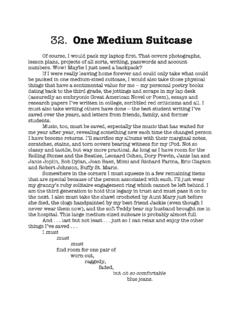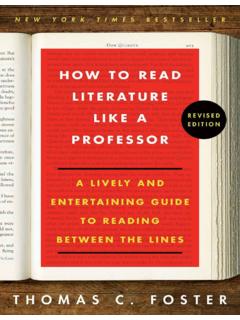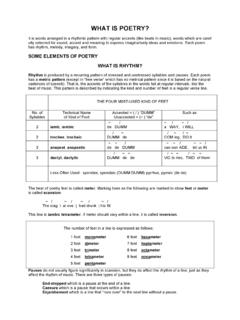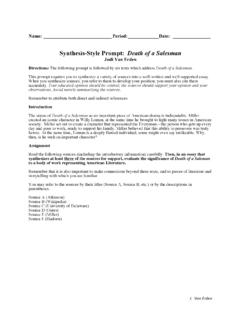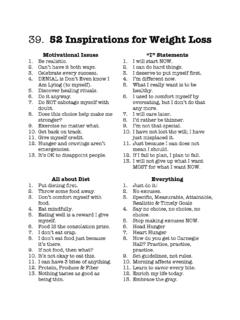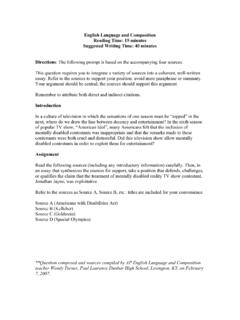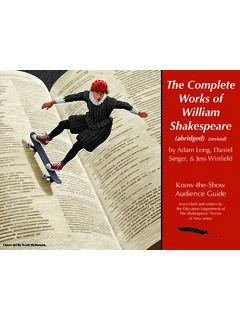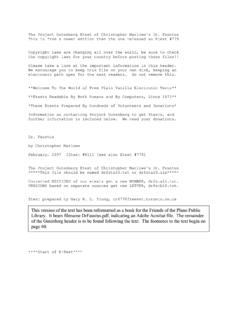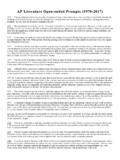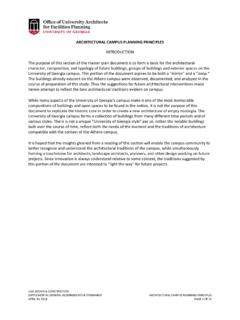Transcription of How to Read Literature Like a Professor - MsEffie
1 How to Read Literature Like a Professor : A Lively and Entertaining Guide to Reading Between the Lines By THOMAS C. FOSTER Contents INTRODUCTION: How d He Do That? 1. Every Trip Is a Quest (Except When It s Not) 2. Nice to Eat with You: Acts of Communion 3. Nice to Eat You: Acts of Vampires 4. If It s Square, It s a Sonnet 5. Now, Where Have I Seen Her Before? 6. When in Doubt, It s from 7..Or the Bible 8. Hanseldee and Greteldum 9. It s Greek to Me 10. It s More Than Just Rain or Snow INTERLUDE Does He Mean That? 11..More Than It s Gonna Hurt You: Concerning Violence 12. Is That a Symbol? 13. It s All Political 14. Yes, She s a Christ Figure, Too 15. Flights of Fancy 16. It s All About 17..Except Sex 18. If She Comes Up, It s Baptism 19. Geography 20..So Does Season INTERLUDE One Story 21. Marked for Greatness 22. He s Blind for a Reason, You Know 23. It s Never Just Heart 24..And Rarely Just Illness 25.
2 Don t Read with Your Eyes 26. Is He Serious? And Other Ironies 27. A Test Case ENVOI APPENDIX Reading List Introduction: How d He Do That? MR. LINDNER? THAT MILQUETOAST? Right. Mr. Lindner the milquetoast. So what did you think the devil would look like? If he were red with a tail, horns, and cloven hooves, any fool could say no. The class and I are discussing Lorraine Hansberry s A Raisin in the Sun (1959), one of the great plays of the American theater. The incredulous questions have come, as they often do, in response to my innocent suggestion that Mr. Lindner is the devil. The Youngers, an African American family in Chicago, have made a down payment on a house in an all-white neighborhood. Mr. Lindner, a meekly apologetic little man, has been dispatched from the neighborhood association, check in hand, to buy out the family s claim on the house. At first, Walter Lee Younger, the protagonist, confidently turns down the offer, believing that the family s money (in the form of a life insurance payment after his father s recent death) is secure.
3 Shortly afterward, however, he discovers that two-thirds of that money has been stolen. All of a sudden the previously insulting offer comes to look like his financial salvation. Bargains with the devil go back a long way in Western culture. In all the versions of the Faust legend, which is the dominant form of this type of story, the hero is offered something he desperately wants power or knowledge or a fastball that will beat the Yankees and all he has to give up is his soul. This pattern holds from the Elizabethan Christopher Marlowe s Dr. Faustus through the nineteenth-century Johann Wolfgang von Goethe s Faust to the twentieth century s Stephen Vincent Ben t s The Devil and Daniel Webster and Damn Yankees. In Hansberry s version, when Mr. Lindner makes his offer, he doesn t demand Walter Lee s soul; in fact, he doesn t even know that he s demanding it. He is, though. Walter Lee can be rescued from the monetary crisis he has brought upon the family; all he has to do is admit that he s not the equal of the white residents who don t want him moving in, that his pride and self-respect, his identity, can be bought.
4 If that s not selling your soul, then what is it? The chief difference between Hansberry s version of the Faustian bargain and others is that Walter Lee ultimately resists the satanic temptation. Previous versions have been either tragic or comic depending on whether the devil successfully collects the soul at the end of the work. Here, the protagonist psychologically makes the deal but then looks at himself and at the true cost and recovers in time to reject the devil s Mr. Lindner s offer. The resulting play, for all its tears and anguish, is structurally comic the tragic downfall threatened but avoided and Walter Lee grows to heroic stature in wrestling with his own demons as well as the external one, Lindner, and coming through without falling. A moment occurs in this exchange between Professor and student when each of us adopts a look. My look says, What, you don t get it? Theirs says, We don t get it.
5 And we think you re making it up. We re having a communication problem. Basically, we ve all read the same story, but we haven t used the same analytical apparatus. If you ve ever spent time in a Literature classroom as a student or a Professor , you know this moment. It may seem at times as if the Professor is either inventing interpretations out of thin air or else performing parlor tricks, a sort of analytical sleight of hand. Actually, neither of these is the case; rather, the Professor , as the slightly more experienced reader, has acquired over the years the use of a certain language of reading, something to which the students are only beginning to be introduced. What I m talking about is a grammar of Literature , a set of conventions and patterns, codes and rules, that we learn to employ in dealing with a piece of writing. Every language has a grammar, a set of rules that govern usage and meaning, and literary language is no different.
6 It s all more or less arbitrary, of course , just like language itself. Take the word arbitrary as an example: it doesn t mean anything inherently; rather, at some point in our past we agreed that it would mean what it does, and it does so only in English (those sounds would be so much gibberish in Japanese or Finnish). So too with art: we decided to agree that perspective the set of tricks artists use to provide the illusion of depth was a good thing and vital to painting. This occurred during the Renaissance in Europe, but when Western and Oriental art encountered each other in the 1700s, Japanese artists and their audiences were serenely untroubled by the lack of perspective in their painting. No one felt it particularly essential to the experience of pictorial art. Literature has its grammar, too. You knew that, of course . Even if you didn t know that, you knew from the structure of the preceding paragraph that it was coming.
7 How? The grammar of the essay. You can read, and part of reading is knowing the conventions, recognizing them, and anticipating the results. When someone introduces a topic (the grammar of Literature ), then digresses to show other topics (language, art, music, dog training it doesn t matter what examples; as soon as you see a couple of them, you recognize the pattern), you know he s coming back with an application of those examples to the main topic (voil !). And he did. So now we re all happy, because the convention has been used, observed, noted, anticipated, and fulfilled. What more can you want from a paragraph? Well, as I was saying before I so rudely digressed, so too in Literature . Stories and novels have a very large set of conventions: types of characters, plot rhythms, chapter structures, point-of-view limitations. Poems have a great many of their own, involving form, structure, rhythm, rhyme. Plays, too.
8 And then there are conventions that cross genre lines. Spring is largely universal. So is snow. So is darkness. And sleep. When spring is mentioned in a story, a poem, or a play, a veritable constellation of associations rises in our imaginative sky: youth, promise, new life, young lambs, children and on. And if we associate even further, that constellation may lead us to more abstract concepts such as rebirth, fertility, renewal. Okay, let s say you re right and there is a set of conventions, a key to reading Literature . How do I get so I can recognize these? Same way you get to Carnegie Hall. Practice. When lay readers encounter a fictive text, they focus, as they should, on the story and the characters: who are these people, what are they doing, and what wonderful or terrible things are happening to them? Such readers respond first of all, and sometimes only, to their reading on an emotional level; the work affects them, producing joy or revulsion, laughter or tears, anxiety or elation.
9 In other words, they are emotionally and instinctively involved in the work. This is the response level that virtually every writer who has ever set pen to paper or fingertip to keyboard has hoped for when sending the novel, along with a prayer, to the publisher. When an English Professor reads, on the other hand, he will accept the affective response level of the story (we don t mind a good cry when Little Nell dies), but a lot of his attention will be engaged by other elements of the novel. Where did that effect come from? Whom does this character resemble? Where have I seen this situation before? Didn t Dante (or Chaucer, or Merle Haggard) say that? If you learn to ask these questions, to see literary texts through these glasses, you will read and understand Literature in a new light, and it ll become more rewarding and fun. Memory. Symbol. Pattern. These are the three items that, more than any other, separate the professorial reader from the rest of the crowd.
10 English professors, as a class, are cursed with memory. Whenever I read a new work, I spin the mental Rolodex looking for correspondences and corollaries where have I seen his face, don t I know that theme? I can t not do it, although there are plenty of times when that ability is not something I want to exercise. Thirty minutes into Clint Eastwood s Pale Rider (1985), for instance, I thought, Okay, this is Shane (1953), and from there I didn t watch another frame of the movie without seeing Alan Ladd s face. This does not necessarily improve the experience of popular entertainment. Professors also read, and think, symbolically. Everything is a symbol of something, it seems, until proven otherwise. We ask, Is this a metaphor? Is that an analogy? What does the thing over there signify? The kind of mind that works its way through undergraduate and then graduate classes in Literature and criticism has a predisposition to see things as existing in themselves while simultaneously also representing something else.
